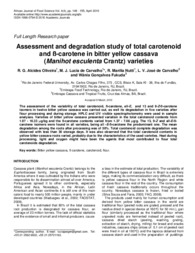Assessment and degradation study of total carotenoid and ß-carotene in bitter yellow cassava (Manihot esculenta Crantz) varieties.
Assessment and degradation study of total carotenoid and ß-carotene in bitter yellow cassava (Manihot esculenta Crantz) varieties.
Author(s): OLIVEIRA, R. G. A.; CARVALHO, M. J. L. de; NUTTI, R. M.; CARVALHO, L. V. J. de; FUKUDA, W. G.
Summary: The assessment of the variability of total carotenoid, ß-carotene, all-E, and 13 and 9-Z-ß-carotene isomers in twelve bitter yellow cassava was carried out, as well its degradation in five varieties after flour processing and during storage. HPLC and UV/ visible spectrophotometry were used in sample analyses. Varieties of bitter yellow cassava presented variation in the total carotenoid contents from 1.97 - 16.33 ?g/ bg and the ß-carotene contents varied from 1.37 - 7.66?g/ g. The 13, 9-Z and all-E-ß-carotene isomers were found in all varieties, being all-E-ß-carotene the predominant one. The mean degradation among the roots after processing was of 50%. Total carotenoid complete degradation was observed with less than 30 storage days. It was also observed that the total carotenoid contents in yellow bitter cassava roots varied, probably due to the characteristics of the used varieties. Heat during processing, light and oxygen might have been the agents that most contributed to flour total carotenoids degradation.
Publication year: 2010
Types of publication: Journal article
Unit: Embrapa Food Technology
Keywords: Beta-carotene, Beta-caroteno, Carotenoide, Carotenoids, Cassava, Farinha, Mandioca
Observation
Some of Embrapa's publications are published as ePub files. To read them, use or download one of the following free software options to your computer or mobile device. Android: Google Play Books; IOS: iBooks; Windows and Linux: Calibre.
Access other publications
Access the Agricultural Research Database (BDPA) to consult Embrapa's full library collection and records.
Visit Embrapa Bookstore to purchase books and other publications sold by Embrapa.

